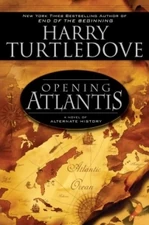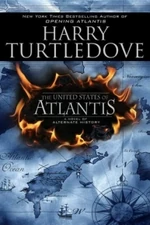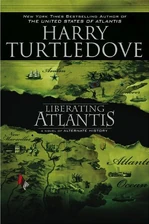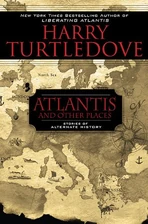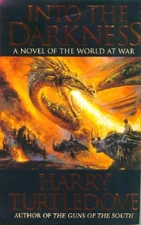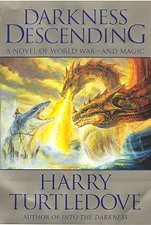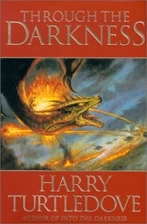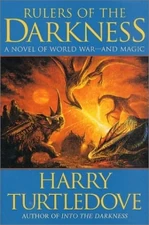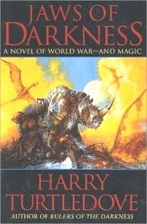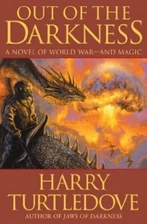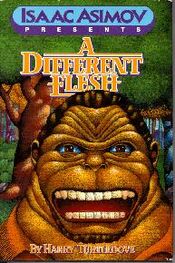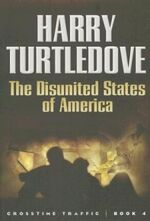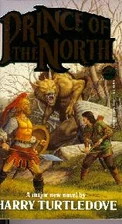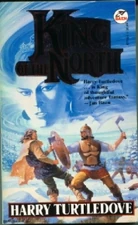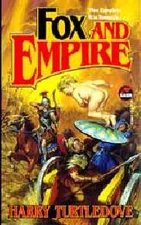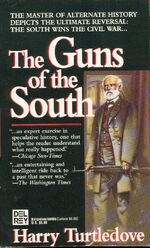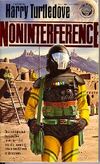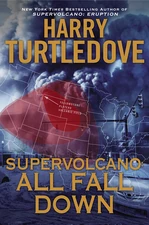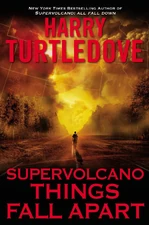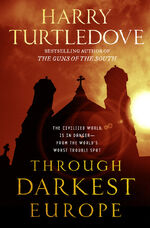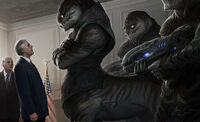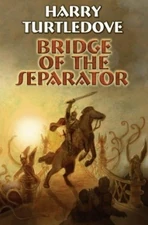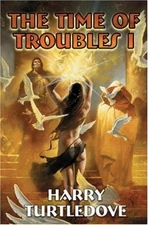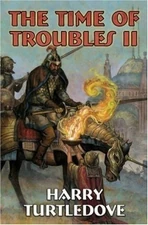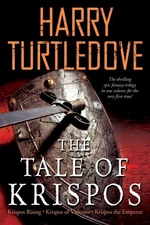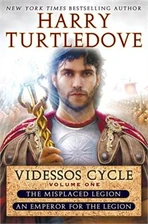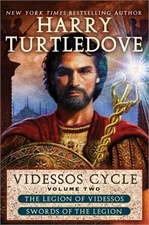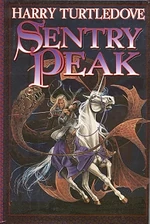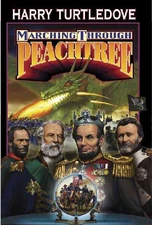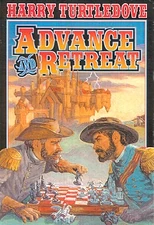The following is a list of the fictional wars known to have taken place in one of the fictional works of Harry Turtledove and/or Laura Frankos. Because they are usually only mentioned in passing, with limited information as to the causes, belligerents involved, duration, and outcomes, they have not been given individual entries nor this wiki's usual in-universe descriptions.
As Turtledove leaves many of these wars unnamed, descriptive names have been assigned by this wiki for simplicity's sake. Wars that were unnamed in-universe are marked with an asterisk (*).
"After the Last Elf is Dead"
- War Between the Dark and the Light*, when the Western Realm (ruled by the High King) was overrun by the forces of the Dark Brother. The story depicts the very last thrust of the war, and its immediate aftermath. Turtledove has implied that the war is meant to be a generic analog of all the better-known good-versus-evil conflicts in fantasy literature, and therefore not defined too precisely; he simply wanted to explore the question of what if evil was the winner for a change.
Alpha and Omega
- Syrian Civil War*. The already-ongoing civil war in Syria is exacerbated when an Israeli airstrike kills the country's dictatorial President.[1] There are no fewer than 17 sides in the conflict. By the end of the novel, the conflict seems to be winding down, with the Russian, Turkish, and Iranian interventions pulling out, though this could simply be the calm before the storm.[2]
- Kosovo War*. Albania and Serbia, using Kosovo as a battleground, suddenly begin talking peace after the Middle East is shaken by an undisputed act of Divine intervention. Whether this peace will last is anyone's guess.[3]
Atlantis
- Anglo-Dutch Wars*. By 1666, Holland had defeated England at sea twice.[4] Analog of an OTL series of wars.
- Anglo-French War*, ongoing in 1809, when Great Britain diverted resources from this war with France to enter into a concurrent conflict with the United States of Atlantis.[5] This seems to be a vague analog of the Napoleonic Wars. Napoleon himself is never mentioned in the series, but Arthur Wellesley, 1st Duke of Wellington and the Battle of Austerlitz are.
- Anglo-Afghan War*. In the 1860s or '70s, Great Britain attempted to conquer Afghanistan and failed bloodily. James Walton one of the few British soldiers to survive and escape. Possibly an analog of an OTL war.[6]
"Birdwitching"
- Mesopotamia War*, mentioned obliquely in passing, an analog of the Iraq War of the early 21st century.[7]
"Bluff"
- Kussara-Maruwas Wars*, a periodic conflict. As the story ends, Maruwas appears to be preparing a new raid on Kussara. The Kussaran General Tushratta sees this as an opportunity to overthrow King Pitkhanas. The outcome of the conflict is never revealed.[8]
"The Castle of the Sparrowhawk"
- Etchmiadzin Civil War*. After the vizier of Etchmiadzin seized the title of Prince, a small number of nobles rose up in an attempt to restore the deposed Rupen to the throne. The majority supported the new ruler, who maintained his throne after a string of hard-earned victories.[9]
Chicxulub Asteroid Missed
- Eastern War*, referred to in "Bonehunters" as "the big war back east", possibly an analog of the American Civil War.
Crosstime Traffic
Home timeline
- The Second Iranian Intervention was a war in the 21st century. The United States and the European Union had sent troops into Iran on the side of the monarchy, but things didn't go the way they planned. It is not clear whether the restoration of the monarchy is a result of the Second Intervention or its cause.
Curious Notions
- Russian Civil War*. Following its defeat by Germany in an analog of World War I, the Russian Empire had a long civil war and permanently fell to pieces, so that there was no Russian nation by the 1930s. Whether the belligerents and root causes resembled those of the home timeline's Russian Civil War is unclear.
- War of the 1930s*. Germany faced the revanchist attacks of Great Britain and France in the late 1930s, and triumphed once again, becoming the undisputed master of Europe.
- War of 1956*. Germany, led by Kaiser Wilhelm IV, attacked the United States with atomic bombs, destroying a dozen cities in one day. Within two months, Germany had invaded and occupied the whole country. By 2096, the United States remained an occupied vassal state of the Kaiserreich.
The Disunited States of America
- War of 1812; Virginia was a belligerent. The relation between this war and the home timeline War of 1812, if any, is unrevealed.
- War of 1833, Virginia was a belligerent.
- First Northeastern War, Virginia was not a belligerent.
- Second Northeastern War 1837, Massachusetts annexed Rhode Island. Virginia doesn't seem to have been a participant.
- Third Northeastern War; Virginia doesn't seem to have been a participant.
- Rocky Mountain War; which saw Deseret establish its independence.
- First Ohio-Virginia War
- Three States' War; Virginia was a participant.
- First Black Insurrection; a revolt of Negroes in Virginia.
- Great War; an analog of World War I, wherein different North American states sided with either the British or the Prussians and fought against each other.
- Second Black Insurrection; a second revolt of Negroes in Virginia.
- Atlantic War; Virginia was a participant.
- War of the Three Emperors, circa 1947, in which Russia was a participant, and Tsaritsyn was the site of an apocalyptic battle. Possibly a loose analog of World War II.
- Florida Intervention; Florida was partitioned into three areas, the southernmost was annexed to Cuba. Virginia was a participant.
- Mississippi Revolution*, c. 1977. The white-ruled government of Mississippi was overthrown by a general uprising of the nation-state's black population, who founded a regime which was equally oppressive against their former rulers. This situation, unique in North America, remained in place in 2097.
Gunpowder Empire
- Roman-Lietuvan Wars*. Rome and Lietuva, the two greatest empires in Europe, fight sporadic border wars which result in plunder and transfer of territory, although neither empire can ever hope to conquer the other completely. The later chapters of the novel depict the Polisso front of one such war, c. AD 2095.
Miscellaneous alternates
- World War VI, referenced in passing in Gunpowder Empire, fought between the United States and the Soviet Union in a 2090s where nuclear weapons had never been invented.
Darkness
- Lagoas-Kuusamo Wars*, mentioned in passing in relation to war memorials in Setubal.[10]
- Lagoas-Valmiera Wars*, mentioned in passing in relation to war memorials in Setubal.[11]
A Different Flesh
- American Revolution*, referenced in broad strokes in "The Iron Elephant" and "Though the Heavens Fall." C. 1738, England's North American colonies broke away to form the Federated Commonwealths of America. An analog of the OTL American Revolution, though there are several obvious differences between the two.
- Russo-Prussian War, referenced fleetingly in "Freedom." An apparent analog of World War II, with iconic horrifying images of emaciated concentration camp survivors.[12]
"Drang von Osten"
- War of the German Coalition*. Germany leads a coalition of European nations to overthrow the Chinese force which has invaded and occupied Russia in the early 2040s, passing through many of the same routes used by the various armies in World War II. The story deals with a limited perspective of one front of the war.
Earthgrip
- T'Kai-M'Sak Wars*, ongoing conflicts between the citified T'Kai and the nomadic M'Sak, members of the G'Bur species of planet L'Rau, fought with medieval weaponry and tactics. The story "6+" focuses on the latest round of fighting, which pulled the Flying Festoon into it.
Elabon
- Kortys-Siphnos War*. Kortys and Siphnos, the two most powerful nation-states in Sithonia, led rival confederacies which bled each other dry in an epic war. Kortys appeared to win, but any victory was short-lived, as the Elabonian League (soon to be the Elabonian Empire) swept in and overran the weakened region.[13] The Peloponnesian War appears to be the basic model, although the precise details vary.
- Sithonian Revolution*, begun in Fox and Empire. The Elabonian Empire's province of Sithonia seeks independence, striking while the iron is hot as a result of the Elabonian Civil War. It is reported that the god Mavrix is personally leading the rebels. After the Civil War ends, the Empire pulls its surviving troops out of North Elabon to deal with the rebels. The final outcome remains unknown at series' end.
"The Emperor's Return"
- Soviet-Turkish War*. In 2003, the Soviet Union invaded Turkey with the aid of Greece. The story focuses on one battle - the Greek capture of Istanbul - and leaves the war's overall scope only vaguely defined.
The Guns of the South
- War of the Triple Alliance*. In 1866, Paraguay is at war against all its neighbors, in an analog of an OTL war.
- Anglo-American War*. In 1867, three years after the Confederate States won the Second American Revolution, the rump United States initiate a war against Great Britain with goal of occupying Canada and neighboring colonies in whole or in part. While the United States have an advantage, in the form of reverse-engineered AK-47s, Britain continues to dominate at sea, shelling several US coastal cities. When the novel ends in 1868, the war is still raging. The US appear to be winning, although Britain is by no means out of the fight.
"The Last Word"
- Final War. In S.M. Stirling's Draka timeline, the Final War is the centerpiece of The Stone Dogs (third volume in the original series), fought in 1998 between the Domination on one side and the USA and its allies on the other. Turtledove sets his story in the immediate aftermath of this war after the main theater of fighting has been completed. There are references to other wars from Stirling's universe, but they are peripheral to this story's plot.
"Leg Irons, the Bitch and the Wardrobe"
- Leffing Wars*. King Pennilvath led Leffing to victory in two undescribed wars before the story starts.
Noninterference
- South African Revolution*, wherein South Africa's native black people overthrew the Afrikaaners who ruled by Apartheid. Many of the former ruling class fled to a remote planet in the proto-Federacy and formed a culture alongside Guatemalans.
"The Pugnacious Peacemaker"
- Tawantiinsuuju-dar al-Harb Wars*. By 1941, the Inca Empire and the neighboring Muslim emirate have been fighting for dominance of South Skrelleland for generations. In 1913, the Incas won a significant amount of new territory in the latest round of fighting. In 1941, the war threatens to erupt again, to the benefit of no one, so ICCS Judge Ib Scoglund is brought in to prevent such an outbreak.
"The Road Not Taken"
- The Second Syrian Crisis in the 2030s caused the United States to reintroduce conscription. Billy Cox was part of the mass buildup of the United States Army as a result of this.[14]
"Running of the Bulls"
- Ecnarfish War*. A vague analog of World War I, this global war was fought nearly a decade before the story takes place. One front of the war was fought in Ecnarf and involved soldiers from Dubyook (including Baek Jarns and Obert Ohn) and Dunlin (including Kime Kelbam) as allies. Astilia remained neutral throughout. The overall scope of the war is unrevealed, as is the name of any nation on the other side.
Southern Victory
- Peruvian War*; Peru fought a war with its neighbors in the years following the Great War. Confederate mercenaries connected to Jake Featherston's Freedom Party fought on behalf of Peru to build experience in warfare.
Supervolcano
- Iran-Israel War*: After the Yellowstone Supervolcano had erupted and weakened the United States, Iran launched a nuclear strike on Tel Aviv. The Israelis responded in kind on both Tehran and Qom.[17] The subsequent happenings are not addressed.
- War of Russian Aggression*: Some six years after the eruption of the Yellowstone Supervolcano, famine-ridden Russia invaded fertile Ukraine and Kazakhstan, only to encounter fierce resistance. Chechens with Russia's borders took the opportunity to rebel, and Russia became hopelessly bogged down.[18]
Through Darkest Europe
- Indian Wars*, fought in the mid 20th century AD. Indian warlord Faruq al-Ghaznavi fought against numerous other nations and was defeated, but not before he engineered the Tamil Holocaust. Apparently analogous to World War II.[19]
- Iraq-Persia Wars*, sporadic conflicts between Iraq and Persia are referenced in broad strokes. Possibly analogous to the OTL wars between Iraq and Iran, in particular the 1980s war which involved World War I-style trench warfare.[20]
"Trantor Falls"
- Sack of Trantor, an event from Isaac Asimov's Foundation Series, frequently referenced but never depicted by him. "Trantor Falls" depicts events around the Galactic University. The First Galactic Empire has fallen, and its capital planet-world of Trantor is overrun by the war chief Gilmer.
The Two Georges
- Nuevespañolan War*, fought between the British Empire and the Franco-Spanish Holy Alliance in the early 1860s.[21] It resulted in American annexation of territory from Nueva España which became the Provinces of Cranmer, Phoenix, Upper California, and Lower California. A vague analog of the OTL Mexican-American War.
Videssos
- Twin Avtokrators War*. Circa 150 years before Hammer and Anvil takes place, a pair of twins were next in line to the throne of Videssos. Neither would admit to being the younger, and their rivalry for the throne tore the Empire apart. Khamorth nomads took the opportunity to invade the Empire, and both Avtokrators hired mercenaries from among the raiders. The outcome of the war is not revealed.[22]
- Videssian Civil War (Fool vs. Butcher)*. In "A Difficult Undertaking," two men known only as "the fool and the butcher" are vying for the title of Avtokrator, tearing the Empire of Videssos apart. The conflict is only dimly referenced, and its outcome is unrevealed.
"Vilcabamba"
- Krolp Wars*. Over the course of the 22nd century, the alien Krolp conquered most of Earth. The story deals with the final stand of independent humans in the North American theatre, with the overall scope of the wars only vaguely alluded to.
The War Between the Provinces
- Blond Wars*. Dark-haired people from the mother kingdom settled western Detina, a development which was not so agreeable the blond people who already lived there. The dark-hairs and the blonds fought several wars for this reason. The blond side had bronze and fairly weak gods, while the dark-hairs had iron and much stronger gods. The result of these wars, which included the Battle of the Three Rivers, was the founding of the Kingdom of Detina, and the enserfment of many blond tribes.
- War of 1218. Hesmucet, the king of a blond tribe, scored major tactical victories against the Detinans, but was ultimately killed and his side defeated.[23] While "War of 1218" is an anagram of "War of 1812," it is not clear how closely the two wars resemble each other. As the years of the Detinan Civil War are never numbered, the Civil War may have happened as few as 50, or as many as 200, years after 1218. Whether the mother kingdom was the prime enemy is unrevealed, as is whether it took place concurrently with Kermit's invasion of Sorb.
- Kermitic Wars*. Approximately 50 years before the Detinan Civil War, Great King Kermit invaded Sorb and occupied Pahzbull. A vague analog of the Russian phase of the Napoleonic Wars, it is not known whether the invasion took place concurrent with the War of 1218.
References
- ↑ Alpha and Omega, pgs. 81-82.
- ↑ Ibid., pg. 465.
- ↑ Ibid., pg. 465.
- ↑ Opening Atlantis, p. 180.
- ↑ Liberating Atlantis, p. 47-48.
- ↑ See e.g.: Atlantis and Other Places, pgs. 384-386, HC.
- ↑ We Install and Other Stories, p. 133.
- ↑ E.g., 3xT, pgs. 244-245. HC.
- ↑ 3xT, p. 408, HC.
- ↑ Into the Darkness, p. 120, HC.
- ↑ Ibid.
- ↑ A Different Flesh, p. 288.
- ↑ Werenight, 1994 ed., pgs. 138-139.
- ↑ See e.g. Kaleidoscope, pg. 180, mpb.
- ↑ Walk in Hell, p. 28, HC.
- ↑ How Few Remain, p. 250, HC.
- ↑ Eruption, pg. 325.
- ↑ Things Fall Apart, pg. 160, 163, 176, 281, 345.
- ↑ Through Darkest Europe, pg. 50, HC.
- ↑ Ibid., pg. 140.
- ↑ The Two Georges, p. 19, HC. In 1995, it has been "a century and a third" since New Liverpool's incorporation into the North American Union.
- ↑ Hammer and Anvil, Chapter II, 1st ed., p. 52; The Time of Troubles I, pgs. 430-431.
- ↑ Sentry Peak, p. 280; Marching Through Peachtree, p. 9.

